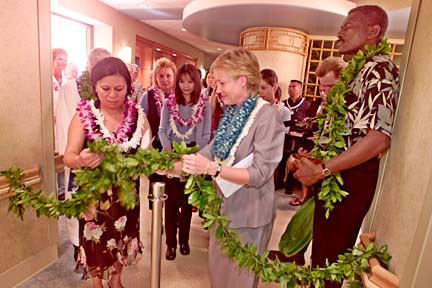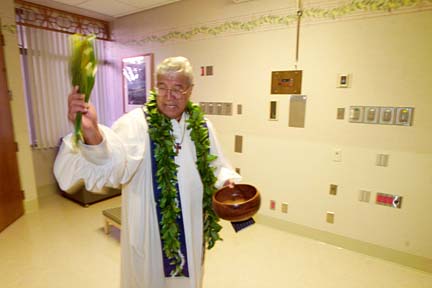
DENNIS ODA / DODA@STARBULLETIN.COM
Queen's neuroscience unit secretary Fides Sipin, left, and nurse manager Tina Harvell parted a maile lei as the Rev. Al Miles looked on yesterday during a blessing and open house. The unit's new home in Queen Emma Tower 5 emphasizes patient comfort in a healing environment.
Queen’s neuroscience
unit builds in comfort
Patients will find hotel-style rooms that are homey at a new neuroscience unit at the Queen's Medical Center.
That's what they said they wanted in a survey, said Michelle Hadano, clinical coordinator for planning, and they'll get much more in the state-of-the-art unit that opens Aug. 19 in Queen Emma Tower 5.
"I've never seen anything like it," Dr. Reinhold Penner, director of the hospital's Center for Biomedical Research, said during a blessing and open house for the 42,960-square-foot unit yesterday. "It is ideally suited to have people get well."
The unit, which cost more than $5 million to build, is part of the Neuroscience Institute. It includes an Epilepsy Center, a Stroke Center with a team that responds to acute strokes around the clock, cardiac telemetry monitoring for neurologic patients and medical-surgery, rehabilitation and therapy services.
All neuroscience patients -- those with stroke, traumas with head injuries and brain surgery -- will be cared for in the new unit except those needing intensive care.
It replaces the Pauahi 4 neuroscience unit, which has two patients to a room and is so cramped the staff jokes that doctors have to reserve a seat to do charts, said Dr. Cherylee Chang, medical director for the Neuroscience Institute and Neurocritical Care and president of the Heart Association of Hawaii board of directors.
Arthur Ushijima, Queen's president and chief executive officer, said more than two years of work by nurses, doctors, staff, companies and others went into planning, design and construction of the 40-bed unit.
"We're not competing with local hotels," he said, but "the staff was determined to provide what patients needed."
The goal was to create a more comprehensive healing environment and care for patients and family members, he said. "This is a nursing unit for this part of the new millennium."
DENNIS ODA / DODA@STARBULLETIN.COM
Rev. William Kaina blessed a room in the new Neuroscience Unit at Queen's Medical Center.
"It's beautiful as well as a healing environment," Chang said.
The unit has incorporated design concepts around the world, such as Disney Institute's use of "on-stage and offstage areas" for theme park cast members, which a Queen's team saw at the University of Chicago, Chang said.
A key element is a bridge (which some call the "Chang bridge" in her honor) that crosses over the fourth floor courtyard, taking people from the elevators directly to a water feature in the neuroscience unit.
The corridors become off-stage areas to wheel patients around in privacy while visitors go to patients' rooms via the on-stage bridge.
Extensive use of glass and openness was adapted from Clarion Hospital in Indianapolis to increase visibility, Chang said. And from Bumrungrad Hospital in Bangkok, she borrowed the idea of medication drawers opening into patients' rooms and stocked from outside.
The unit's theme is "gathering places and water," said Chang, noting art on the walls and around the water feature "pulls the viewer to a calm, peaceful place."
Flooring is used for way-finding instead of signs. For instance, a sand pattern guides family members and visitors.
Patients have private rooms with specially designed maile borders on the walls and ferns on the ceilings so they don't get bored lying in bed. In the elevators, patients on gurneys can look up at colorful flower art in the ceilings.
Even the light fixtures are unique, containing real bamboo, Hadano noted. "Many people want them for their homes."
Staff members touring the facility yesterday said they're thrilled with it. Chang said it's much more efficient and easier to work in, with a lot of new technology, such as computerized imaging systems that can be wheeled into rooms.
Closer patient monitoring will be possible with a nursing station for every two rooms. Medications, supplies, charts and records are next to each room so nurses don't have to wander all over looking for them, Chang pointed out.
Constance Black, first vice chairwoman of Queen's board of trustees, said the neuroscience center was inspired by a former hospital trustee who had an aneurysm. "The board felt so helpless. I can't help thinking, if we had all this, her quality of life would be better."

